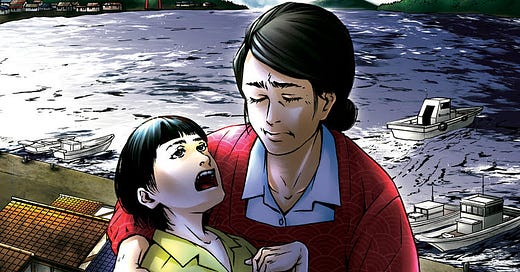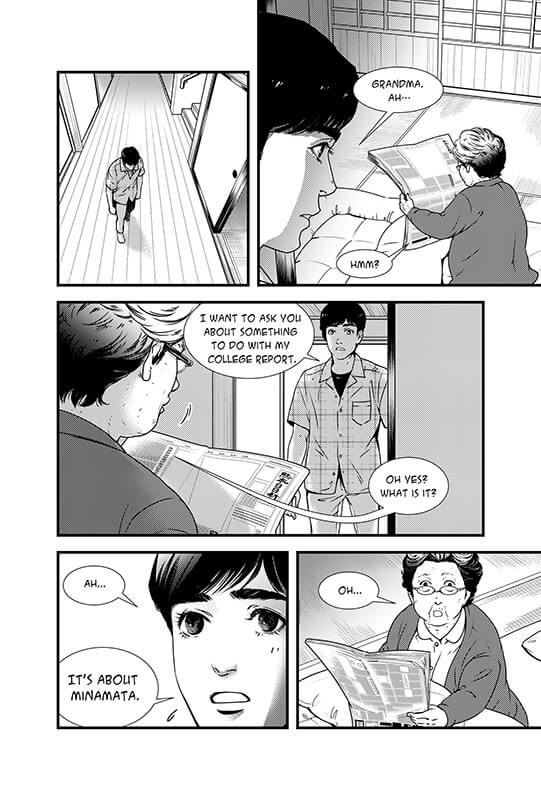One of the most shameful and haunting episodes in recent Japanese history is a case of mercury poisoning that occurred in the late 1950s. It is usually called Minamata disease from the name of the city in Kumamoto Prefecture where it was first discovered in 1956.
Last year, writer Sean Michael Wilson and comic artist Shimojima Akiko published a beautiful and thought-provoking work on this controversial case. The following interview with Wilson - a fellow substacker - originally appeared in Japan Forward.
The Tragedy
One might be shocked to see this word: EcoTragedy. But it perhaps only scratches the surface of what people in Minamata City suffered as events unfolded starting from the early 1950s.
At the time, strange symptoms started appearing in the community of Minamata, Kumamoto Prefecture, in Kyushu Japan.
The striking image of ominous “dancing cats” is used by many when recounting the shock and confusion at the time. Pictures this:
the feline pets were overtaken by convulsions, moving much like they were part of a disturbing dance.
Formal inquiries were conducted by the local university and the Japanese Ministry of Health and Welfare, which traced the symptoms to a chemical company based in Minamata that was dumping methylmercury waste into the water. High quantities of mercury were being absorbed by the fish, and then in turn by the locals who made up a flourishing fishing community.
The first well-documented case was found in 1956. A 5-year-old girl showed neurological symptoms such as convulsions and difficulty of speaking. Other patients with the same condition were then confirmed. It was calculated that of 54 patients in Minamata diagnosed with similar symptoms since 1953, 17 had died by 1956.
Today known as mercury poisoning, the illness was first called “Minamata disease” in 1957.
One might think that the story ends there, but it doesn’t. Instead, the health crisis also became a social issue. Stigma followed people who came from the area, even when they moved elsewhere. Fishermen suffered as the source of their income was feared contaminated and could not be sold.
An Author Goes Inside Minamata’s History
Are people still affected today? What would it be like to ask someone from Minamata about what happened in their hometown?
These are the questions that manga author Sean Micheal Wilson asks in his new project on the topic of Minamata, called The Minamata Story: An EcoTragedy.
The book, co-authored with Shimojima Akiko, is written from the point of view of a student who takes up the topic of Minamata disease for a high school writing assignment. When he tells his family, he finds out that his grandmother is from the area, but had hidden her origins because of the associated stigma.
Her story becomes an impetus for the young man to learn more. He visits the area, connects with his extended family, and learns how the locals are affected by the tragedy to this day.
Author Sean Michael Wilson talked to JAPAN Forward in an online interview about what pushed him to realize this work, and what he hoped to achieve through the project.
What made you decide to take up the project?
A friend of mine who is an environmental campaigner has a few of my books on social issues and suggested that I do the next one on Minamata. I had heard of it before and thought it was a good idea.
So, he took me down to Minamata to meet with the disease sufferers and those who care for them. They took me on a tour of some key places connected to the issue, and I learned a lot.
Then, we both researched it, for facts and visuals. So, hopefully our book should be largely accurate.
Having written many different manga genres, how was producing this one different?
Much the same process applies to all my books. I research the topic, interest a publisher or funder in a book about it, choose an artist to work with, write the script, work closely with the artist on the art, etc. In most cases, my books are about people from further back in history or far-off places.
The key difference here is that many of the people in this book are still alive, and here in the same areas as I live in. Therefore, I could engage in some direct anthropological style research for this book.
What was the creative process in deciding how to tell the story?
A key thing is often about not putting overly complicated information and experiences in the book. A good way to do that is to have a figure in the book who sees things more or less as the reader will. So, in this case we have a young college student exploring the issue, meeting the people, seeing the places. And as he learns and sees all this, so does the reader. It’s a classic technique in storytelling.
What was the creative relationship with co-author Shimojima Akiko? How did you split the work?
The process of making a comic book or manga is more complicated than most people think. And it takes longer. There are about seven different stages, from coming up with the idea, to the final stage of printing the book. But there are smaller elements within those stages. It needs a whole article to go into it. Basically, I write the story in script format and the artist brings that to life in the illustration process.
With something as complex as Minamata, what do you think are some of the advantages of telling the story through manga instead of other mediums?
I suppose some might still have the old-fashioned idea that manga is for young people only or mainly about fantasy. That has never been true. But especially nowadays, manga and graphic novels are about a very wide range of subjects, many of them suitable for adult readers. They go into issues of history, society, medicine, nature, politics in sophisticated ways.
According to some university studies, the text-art mixture is the best way to process and recall information.
What message do you have for readers and how should they approach your manga?
Simple, without sales, books die. At least they do in this economic system.
So, creators like me doing sophisticated manga and graphic novels need your support in order to keep doing what we do. Anyway, why not have a look and see some of the great range of very interesting books being made nowadays, including our Minamata manga.
Sean writes a very interesting newsletter called A to Z of Anything. It’s one of just a few substacks I read regularly. You can also find more information on Sean’s work on his website.
Thanks for reading, and if it’s your first visit to Tokyo Calling, I hope you will subscribe and spread the word on my writing.





